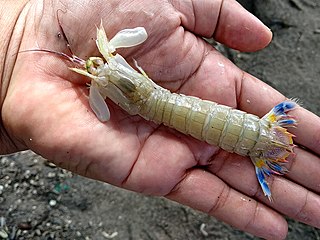
The Caridea, commonly known as caridean shrimp or true shrimp, are an infraorder of shrimp within the order Decapoda. This infraorder contains all species of true shrimp. They are found widely around the world in both fresh and salt water. Many other animals with similar names – such as the mud shrimp of Axiidea and the boxer shrimp of Stenopodidea – are not true shrimp, but many have evolved features similar to true shrimp.

Slipper lobsters are a family (Scyllaridae) of about 90 species of achelate crustaceans, in the Decapoda clade Reptantia, found in all warm oceans and seas. They are not true lobsters, but are more closely related to spiny lobsters and furry lobsters. Slipper lobsters are instantly recognisable by their enlarged antennae, which project forward from the head as wide plates. All the species of slipper lobsters are edible, and some, such as the Moreton Bay bug and the Balmain bug are of commercial importance.

Caridina is a genus of freshwater atyid shrimp. They are widely found in tropical or subtropical water in Asia, Oceania and Africa. They are filter-feeders and omnivorous scavengers. They range from 0.9–9.8 mm to 1.2–7.4 mm in carapace length.
Johannes Govertus de Man, was a Dutch biologist. He was assistant curator at the Rijksmuseum van Natuurlijke Historie in Leiden, where he specialised in free-living nematodes and decapod crustaceans, although he also wrote papers on flatworms, sipunculids and, in his dissertation only, vertebrates. His change away from vertebrates disappointed the director of the museum, and de Man left his job there after eleven years. For the rest of his life, de Man worked at his parents' house in Middelburg and later at a house near the shore at Yerseke in the Oosterschelde estuary, relying on his family's private income.

Athanas is a genus of shrimp of the family Alpheidae. These are small shrimp measuring 2 cm in length. Females have smaller chelae than males.

Lysiosquilla is a genus of mantis shrimp of the family Lysiosquillidae, containing these species:

Palaemonidae is a family of shrimp in the order Decapoda. Many species are carnivores that eat small invertebrates, and can be found in any aquatic habitat except the deep sea. One significant genus is Macrobrachium, which contains commercially fished species. Others inhabit coral reefs, where they associate with certain invertebrates, such as sponges, cnidarians, mollusks, and echinoderms, as cleaner shrimps, parasites, or commensals. They generally feed on detritus, though some are carnivores and hunt tiny animals.

Squillidae is a family of mantis shrimp, the only family in the superfamily Squilloidea. The type genus is Squilla. It is the stomatopod family with the most genera, as follows:
Eurysquillidae is a family of mantis shrimp. Formerly placed in the superfamily Gonodactyloidea, it has since been recognised that eurysquillids are closer to families in the Squilloidea, and so Eurysquillidae has been placed in its own superfamily, Eurysquilloidea. It includes six genera and 30 species
Iais is a genus of isopod crustaceans. Iais species are found in association with larger isopods of the family Sphaeromatidae, usually on the ventral surface of the larger animal, between the pereiopods and on the pleopods. They are native to Australasia and South America, although Iais californica and its host Sphaeroma quoyanum have invaded California, and I. californica was first described from Sausalito, California. Nine species are recognised:
Edward John Miers FZS FLS was a British zoologist and curator of the crustacean collection at the Natural History Museum in London. He contributed to the scientific reports from the Challenger expedition of 1872–1876, and described 32 new genera and at least 260 new species and subspecies of decapod crustaceans, along with four genera and 72 new species in other orders.

Macrobrachium is a genus of freshwater prawns or shrimps characterised by the extreme enlargement of the second pair of pereiopods, at least in the male.

Palaemonella is a genus of shrimp in the family Palaemonidae, containing the following species:

Acanthosquilla derijardi is a species of stomatopod crustacean. Its distribution is widespread throughout the Indo-West Pacific. The species was initially described by the American carcinologist Raymond B. Manning in 1970. Its junior synonym, A. sirindhorn, was named in 1995 in honor of Princess Sirindhorn of Thailand.

Periclimenes, commonly known as glass shrimp or cleaner shrimp, is a commensal and often symbiotic genus of semi-transparent shrimp within the family Palaemonidae. Species of this large genus feature a wide variety of coloration and patterns, widespread distribution throughout much of the world's tropical oceans, and are often sought out for aquarium trade.
Miyakella is a genus of shrimps belonging to the family Squillidae.
Oratosquilla fabricii is a species of mantis shrimp found in the Indo-Pacific. Like other members of its order it has a powerful spear, which it uses to hunt invertebrates and small fish. It grows to a length of 175 millimetres (6.9 in), and lives at depths of 0–135 metres (0–443 ft).

Erugosquilla is a genus of crustaceans belonging to the family Squillidae.. The genus was first described in 1995 by Raymond Brendan Manning. The type species is Erugosquilla massavensis(Kossmann, 1880).
Erugosquilla septemdentata is a species of shrimp in the family, Squillidae, and was first described in 1994 by Shane T. Ahyong as Oratosquilla septemdentata. The name was revised to Erugosquilla septemdentata in 1995 by Raymond B. Manning.












